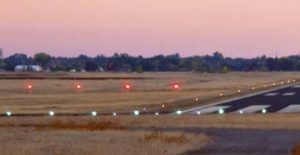by Scott Thompson
The Lincoln airport has a set of four box PAPIs on each end of the runway. PAPIs are the four alternately red and/or white lights arranged in a light bar installed on the left side of both Runways 15 and 33 about 700 feet from the threshold. For many, it might be of interest to get a bit more information about these PAPIs. As a start, PAPI stands for Precision Approach Path Indicator, and it is one of several Visual Glide Slope Indicator (VGSI) systems that are available. Another common VGSI system is the Visual Approach Slope Indicator (VASI), an older design and one being supplanted by PAPIs at many airports. There is a whole section in the Aeronautical Information Manual (Chapter 2, Section 1) about VGSI systems that should prove interesting reading to any pilot, VFR or IFR qualified.
PAPIs are either two box or four box systems; Lincoln has four box systems. The design of PAPIs is such as to give a pilot visual guidance for the desired glidepath which, for Lincoln and most other installations, is a 3.00 degree angle. This angle and the resulting threshold crossing height should match any ILS glideslope and/or an RNAV glidepath for that runway.

The boxes are numbered starting at the runway; the closest box is Box 1 and the furthest box is Box 4. Each of the four boxes is aimed at pre-determined angles
that illuminate a red indication while below that angle, and a white indication when above that angle. Thus, an on-path indication is below the angle for two of the boxes (boxes 1 and 2) and above the angle of the other two boxes (boxes 3 and 4), so the PAPIs will display two red lamps and two white lamps to the pilot on the desired approach path. Three red and one white lamp indicate below path, and four red lamps indicate well below path; the opposite is true for above path indications. The two box PAPI systems are simpler and have just two lamps for guidance. They do not provide as much information but are useful for shorter, non-instrument approach runways.
Information for installed PAPI systems is found in the FAA Chart Supplement (ex A/FD) and other airport information sources like AIRNAV. For example, the Supplement entry for KLHM for RWY 15 is PAPI(P4L) GA 3.0 degrees, TCH 44’ which informs that the PAPIs are a 4 box system installed on the left side of the runway, has a glidepath angle of 3.00 degrees, and the threshold crossing height is 44 feet. A lighting note adds that they can be activated on the CTAF frequency at night.
Installation criteria for VGSI systems is contained in an FAA Order, JO 6850.2, and there are also several FAA Advisory Circulars that assist in the siting and
technical details. One of the requirements for installation is that there should be no obstacles, whether terrain, trees, or man-made, that penetrate an imaginary surface that is established one degree below the angle of the number 3 PAPI box. For a 3.00 degree PAPI angle, Box number 3 is set at 2.83 degrees, so there should be an obstacle clear surface that extends at 1.83 degrees from 300 feet in front of the PAPIs out to four statute miles within 10 degrees each side of runway centerline. This ensures is that a pilot approaching the runway will be clear of obstacles while flying on path (two white, two red indication) or slightly below path (three red, one white indication). For a twobox PAPI system, that obstacle clear surface extends only to two miles.
After the installation is completed, the FAA will usually conduct a flight inspection of the PAPIs to verify the performance of the system. This inspection checks the actual PAPI angle, the lateral coverage (which should extend to 10 degrees each side of centerline), and performs an obstacle check that could extend out to eight miles or more (depending upon the installation) to verify that a solid below path indication will clear all obstacles wherever the lights are visible. The angle check requires that the actual PAPI angle be within plus or minus 0.20 degrees of the desired angle and that the PAPI path be coincident with any electronic or RNAV glidepath (with exceptions allowed under some circumstances).
A word to the wise, though: not all PAPIs have been installed under standard requirements and those systems may have not have been inspected. Depending upon who is paying for the installation (Airport Improvement Program grants, the FAA itself, local airport owners, or Billy Bob (who built up a system in his garage) will
usually determine if the PAPIs are a standard installation or not. Most airports with PAPIs have followed the guidance and are set up properly, but not all. Specific to our Lincoln PAPIs, the two systems are owned by the city of Lincoln and were installed and flight inspected according to the standard criteria.
PAPIs are ideal for aircraft flying stable straight in approaches and are especially useful for night flying into unfamiliar airports or to support instrument approaches. PAPIs at many airports are set up with air-to-ground lighting control, so pilots can turn them on for use, and they automatically dim from 100% brightness for daytime use to 10% brightness for nighttime use.
For aircraft in the local traffic pattern, PAPIs may not be as useful since flying tight patterns will put an airplane well above a normal 3.00 degree glidepath while on base leg and turning final. But, regardless, if you are flying the final approach and you see yourself transitioning from all white PAPIs to all red PAPIs, it should be one additional (though obvious) clue that your landing approach is not going well.
